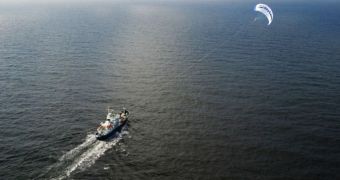It would appear that, in producing electrical energy, scale is everything. Take the Three Gorges Dam for example, which is the largest hydroelectric power plant in the world. But if all countries would build such structures, then we would soon run out of significant rivers. Many individuals trying to extract energy from the sea initially turned to the shores and the tides for this. But the approach is unfeasible in the long-run, and now South Korean researchers are proposing a new approach to harnessing the massive energy potential that the world's oceans have, Wired reports.
The group's idea is a little weird, they too admit. The researchers propose that gigantic kites could be used to drag large and floating power plants across the surface of the world's waters. Each of the power plants would be outfitted with an underwater turbine, which would get activated whenever the entire ensemble moves. The proposal might not make sufficient sense even now, but its scale is what makes it stand out. The kite that would provide the necessary pull would have a surface of about 6.5 million square feet, and will fly approximately one mile above the surface of the ocean.
The researchers believe that this would generate sufficient pull to actually produce massive amounts of electrical energy via this method. Group members go on to say that as much 800 megawatts of electricity could be produced from a single such power plant. Through electrolysis, equipment aboard these generators would separate oxygen from hydrogen, and harvest the latter aboard. But the main issue facing the group is that the materials they need cannot be produced at this time. Still, they don't despair, saying that the proposal will make even more sense as the world progresses technologically.
“The calculation shows that, with a large such ship, a gigawatt order electrical power may be harvested by this system. If such ships are deployed at 20-km (12.4-mile) intervals over two temperate zones, one in the middle of the Pacific Ocean in the Northern Hemisphere and the other everywhere in the Southern Hemisphere, the total power produced will be many times that needed by the world,” researchers write in the March issue of the respected scientific journal Energy. The work was conducted by Korea Aerospace Research Institute scientist Park Chul, who collaborated closely with colleague Kim Jongchul, who is based at the Korea Advanced Institute of Science and Technology.

 14 DAY TRIAL //
14 DAY TRIAL //